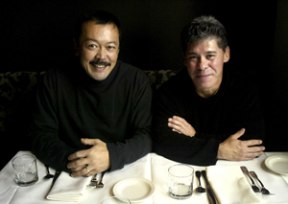The Madoka menu melds local produce with influences from across the ocean.
Entering Madoka is like a study in textures.
The double-height, rippled golden wall at the door contrasts with the restaurant’s spare black interior. Overlapping spirals in shades of red and orange on cushions, and a red wall sheathing stairs to the upper dining area, are striking accents.
“I had the idea of a restaurant that’s eclectic. I liked the serenity of Asia, but wanted to add a Latin kick,†Madoka manager and co-owner, José G. Gonzales said. “We want the plates to look fabulous, the employees to be professional and provide something the island doesn’t have.â€
Says co-owner and chef Alvin Binuya, “It’s not just food, but also service, ambience.â€
Offering pan-Pacific cuisine, Madoka is the first venture in ownership by Binuya and former head waiter Gonzales, who both have had over 25 years experience in Seattle kitchens and dining rooms.
Binuya describes his dishes primarily based on local produce with a Pacific Rim influence; not fusion cuisine, but incorporating the influences of Asian tastes brought to Seattle by immigrant communities one dish at a time.
“We live in an area with some of the best seafood and produce on the planet,†Binuya said. “Being given that and my Asian background, that is my comfort zone.â€
The dinner menu reflects these influences. Small plates priced from $6-$12 include ahi poke with seaweed, yuzu-ginger vinaigrette, a sesame seed tuile and wasabi-cucumber granite or an American Kobe beef quesadilla.
Large plates, including sake-braised Oregon lamb shank and yellowfin tuna tataki with a black sesame seed crust, roasted red and gold beets, olive-oil soy sauce braised baby bok choi with wasabi aioli, run from $16-33.
Binuya grew up on Vashon Island with his parents of Filipino extraction, who kept their own vegetable garden and some pigs and chickens. Japanese workers stayed at their home, and he was eating sushi at age 8. His mother kept a pastry shop on Vashon.
By 9 or 10, he had started cooking family dinners, such as beef stew out of the Boy Scout cookbook, and then “my mom let me have run of the kitchen with the Betty Crocker cookbook.â€
A stroke of luck was landing a job as a line cook at Rosellini’s Other Place in Seattle in the early 1980s, while he was still in the culinary program at South Seattle Community College.
The owner, Robert Rosellini, “was ahead of his time,†Binuya said, in that the chef was able to influence how farms raised game and grew vegetables organically for his tables.
Rosellini knew the fishermen and boats from which he bought seafood.
“As cooks (for Rosellini), we would tour and learn where the food was coming from,†Binuya said. The restaurant was defined by the “potent†French-technique saucings, using local ingredients the chef had a hand in growing.
“That developed my foundation,†Binuya said. “I was blessed.â€
Binuya met Gonzales while they were both working for the Brooklyn in Seattle and again at the Ponti Seafood Grill.
“(That) was a high point in terms of me becoming comfortable with what I do with food,†Binuya said. “I finally developed a style.â€
That style and a mutual yen for perfection caught Gonzales’ eye.
He had lived on the island for 11 years while working in Seattle, and when the former Bistro Pleasant Beach space opened up, he approached Binuya to join him in the venture.
Binuya was still working in Seattle then. He asked Gonzales what his plan B was if he declined.
“You are my plan A, B, C, D…†was the reply.
Binuya accepted.
“It was the opportunity for me. (I knew) the front of the house standards would be kept high, which is as important to me as him,†Binuya said. “I felt I needed to take the next step and express myself through the menu.
“The reason I came here is, there is an intelligent dining community on the island, and that’s really something that appealed to me.â€
“There have been a number of restaurants that have been here to teach,†Gonzales said. “We’re here to be part of the neighborhood. (Island diners are) very critical, (but) they want everybody to succeed.â€
Gonzales got into waiting tables to get out of working on a farm in Eastern Washington. Being a thespian in high school and a bit of a ham by nature didn’t hurt.
“It’s a game, it’s a show,†Gonzales said. “When you’re on the floor, you involve everyone around you. People want to experience the restaurant, they want to be involved and part of the action.â€
It goes back to creating an experience, Binuya says, with the low-end being dinner in front of a TV to the high end, which is “the whole package, it’s not just food and sustenanceâ€
Gonzales crosses his arms across his chest like a grateful Italian opera singer acknowledging applause.
“That’s the response as a server or owner that I want (from patrons),†he said. “It’s that intangible.
“It’s what you’re reaching for.â€
* * * * *
Pot and pan Pacific
Madoka is located at 241 Winslow Way West and is open for dinner Wednesday through Monday from 5:30-10:30 p.m. and is closed Tuesday. Call 842-2448 for information or reservations.


